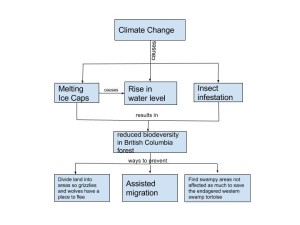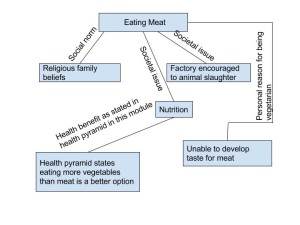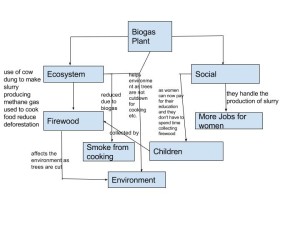Module 10 Geog030
- Draw a diagram using the article “Climate change turns conservationists into triage doctors” discussed in this module to show how it helps the current biodiversity situation
- Explain the diagram above in 250-300 words on how it links to the article and explain the core ideas in relation to what is drawn.
The diagram above shows ways to prevent the reduced biodiversity of species living in the British Columbia habitat. The article includes discussions from various scientists with suggestions on how to protect the wildlife in the area. The basic concept behind the diagram states that due to climate change wildlife is being heavily impacted and causing different species to be endangered. Melting ice caps causing an increase in water levels means there will be less area for animals like grizzlies and wolves therefore a method to protect them was suggested by a scientist. The method involves dividing the land into 90 square meters and analyzing each area in terms of how it will be affected by the climate change, in doing so they will be able to identify what areas of land will be suitable and safe for the wolves and grizzlies to flee to and survive, this way they will be able to protect the species for a certain period of time. Another prevention method listed in the article and in my diagram involves migrating the animals in the habitat by us, as they would not be able to do so due to cities built around them. This however is an extremely difficult task and in my opinion should not even be considered as it will be very difficult to move them and it may come to a situation where decisions are being made on which particular species are to be saved, which in my opinion is not a decision that lies in our hands. Lastly, moving them to other swampy areas that suit their survival methods, which to me is a good way to go about it as only one species is being moved, can save the endangered species of the western swamp tortoise.
- Finally, describe the biodiversity in your town or city and how it is different from what is discussed in the article. (In 150-200 words)
Since Dubai is a desert and there aren’t many animals there, except for camels most importantly reduced biodiversity isn’t that big of an issue. However Dubai does have a turtle rehabilitation center where injured turtles are taken and taken care of until completely recovered. Once, recovered they are sent away back into the wild where the habitat is suitable for them. Apart from this camels have the tendency to graze the land, therefore endangering certain plant species. However in areas where camels do not exist vegetation regeneration has been considerable and therefore protected by the government. The biodiversity in Dubai is considerably different to that of the British Columbia habitat as there aren’t that many species in the area, however the species that do exist are well taken care of as the area is a lot smaller in comparison to that of the forest in B.C., and also a lot less in number compared to that in the forest making it easier to control the animal species in Dubai.



